Business travel
- 84 Health and wellness awareness
- 85 Integrative design
- 86 Post-occupancy surveys
- 87 Beauty and design I
- 88 Biophilia I - qualitative
- 89 Adaptable spaces
- 90 Healthy sleep policy
- 91 Business travel
- 92 Building health policy
- 93 Workplace family support
- 94 Self-monitoring
- 95 Stress and addiction treatment
- 96 Altruism
- 97 Material transparency
- 98 Organizational transparency
- 99 Beauty and design II
- 100 Biophilia II - quantitative
- P5 Health through housing equity
- P6 Education space provisions
91. Business travel
To minimize disruptions to occupants' sleep and fitness regimens, and personal relationships by adopting supportive travel policies.
Business travel is often associated with a number of negative health outcomes. Research from the World Bank indicates that business travel is associated with higher total medical claim costs, with the highest increase attributed to psychological disorders related to stress. Additionally, findings indicate that the main stressors of business travel are impacts on family and personal life, jetlag, increased workload upon return and isolation from family and friends.
In order to reduce stress related to business travel, employers promote the following policies:

Applicability Matrix
| Core & Shell | New & Existing Buildings | New & Existing Interiors | |
|---|---|---|---|
| Part 1: Travel Policy | - | O | O |
Verification Methods Matrix
| Letters of Assurance | Annotated Documents | On-Site Checks | |
|---|---|---|---|
| Part 1: Travel Policy | Policy Document |
| 91.1.c |
CWT Solutions Group’s Stress Triggers for Business Travelers notes that, compared to respondents living alone, respondents living with a partner reported that traveling during the weekends was more stressful. |
| 91.1.d |
In CWT Solutions Group’s Stress Triggers for Business Travelers, "not able to maintain workout routine" was listed as a medium stress factor. |
